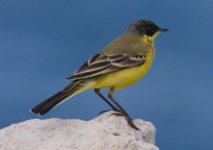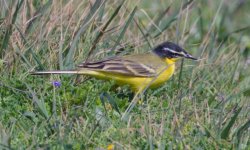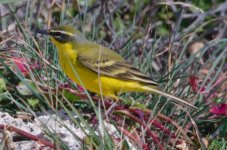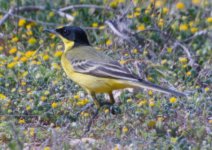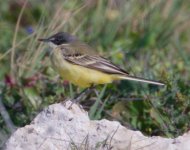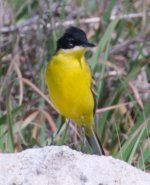DoghouseRiley
Well-known member
Hi All
On a short break I bumped into a flock of what appeared to be "blue-headed" wagtails. There were 8-10, it was hot and sunny and I clicked away until they got bored of me and moved on. So now I am back and I have checked through the pics and........... well, there is a lot of variation.
I managed to get hold of "Eastern yellow wagtails in Europe" (Bot, Groenendijk, van Oosten) and that hasn't helped. The names used below are from Collins 2nd ed.
Pic1 - Maybe M. cinereocapilla? The head colour hasn't fully darkened, white line can be seen under the cheek. Maybe M. "dombrowskii
Pic2 - This seems to look like M. "superciliaris". White strip above the eye but not below the cheek.
Pic3 - This seems to look like M. "superciliaris", just that the head hasn't taken on the dark grey/blue colour yet. Perhaps immature?
Pic4 - This seems to look like M. feldegg. Very dark head, no white.
Pic5 - Maybe M. iberiae? White throat and white above the eye.
Pic6 - This looks like M. feldegg but has a white line under the cheek.
I saw no females (I am presuming these are males). They were feeding on open grass land by the sea and could be migrating in but behaved as though they were part of the same flock. Feeding, looking out, moving from area to area together.
Could someone please take a look and help.
Thanks, Gareth
On a short break I bumped into a flock of what appeared to be "blue-headed" wagtails. There were 8-10, it was hot and sunny and I clicked away until they got bored of me and moved on. So now I am back and I have checked through the pics and........... well, there is a lot of variation.
I managed to get hold of "Eastern yellow wagtails in Europe" (Bot, Groenendijk, van Oosten) and that hasn't helped. The names used below are from Collins 2nd ed.
Pic1 - Maybe M. cinereocapilla? The head colour hasn't fully darkened, white line can be seen under the cheek. Maybe M. "dombrowskii
Pic2 - This seems to look like M. "superciliaris". White strip above the eye but not below the cheek.
Pic3 - This seems to look like M. "superciliaris", just that the head hasn't taken on the dark grey/blue colour yet. Perhaps immature?
Pic4 - This seems to look like M. feldegg. Very dark head, no white.
Pic5 - Maybe M. iberiae? White throat and white above the eye.
Pic6 - This looks like M. feldegg but has a white line under the cheek.
I saw no females (I am presuming these are males). They were feeding on open grass land by the sea and could be migrating in but behaved as though they were part of the same flock. Feeding, looking out, moving from area to area together.
Could someone please take a look and help.
Thanks, Gareth




